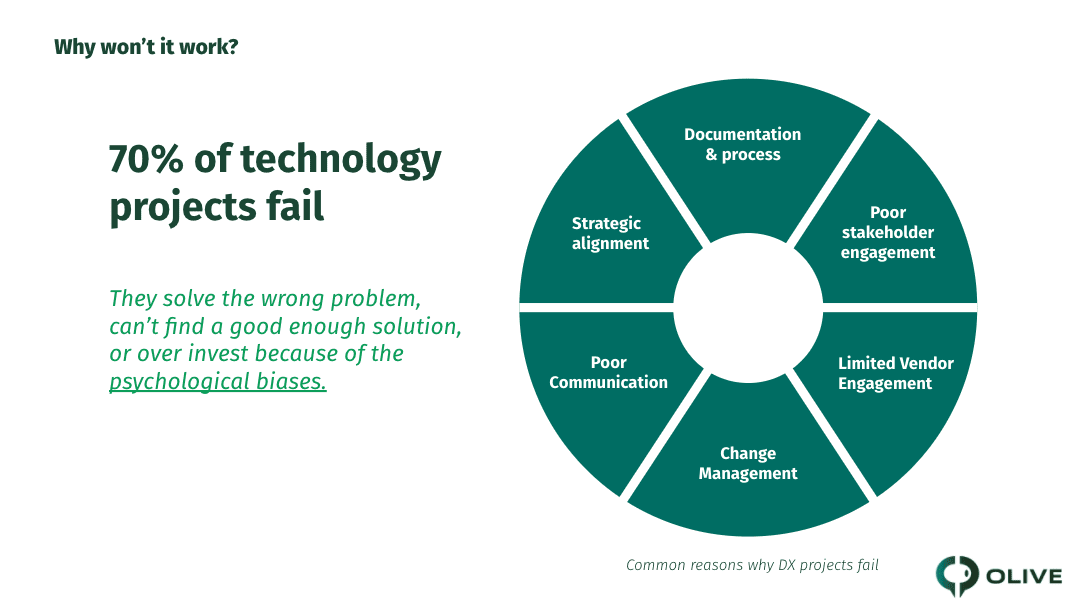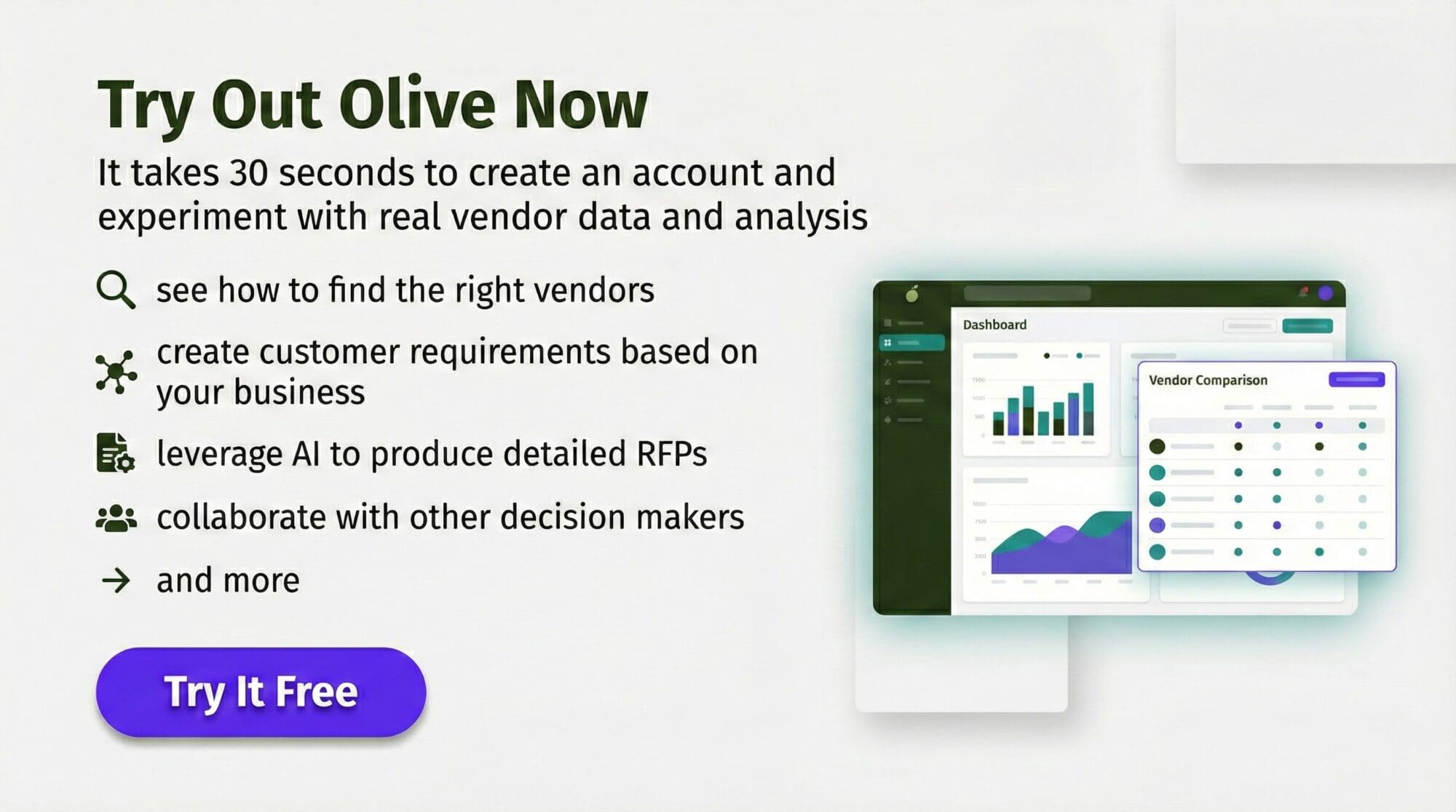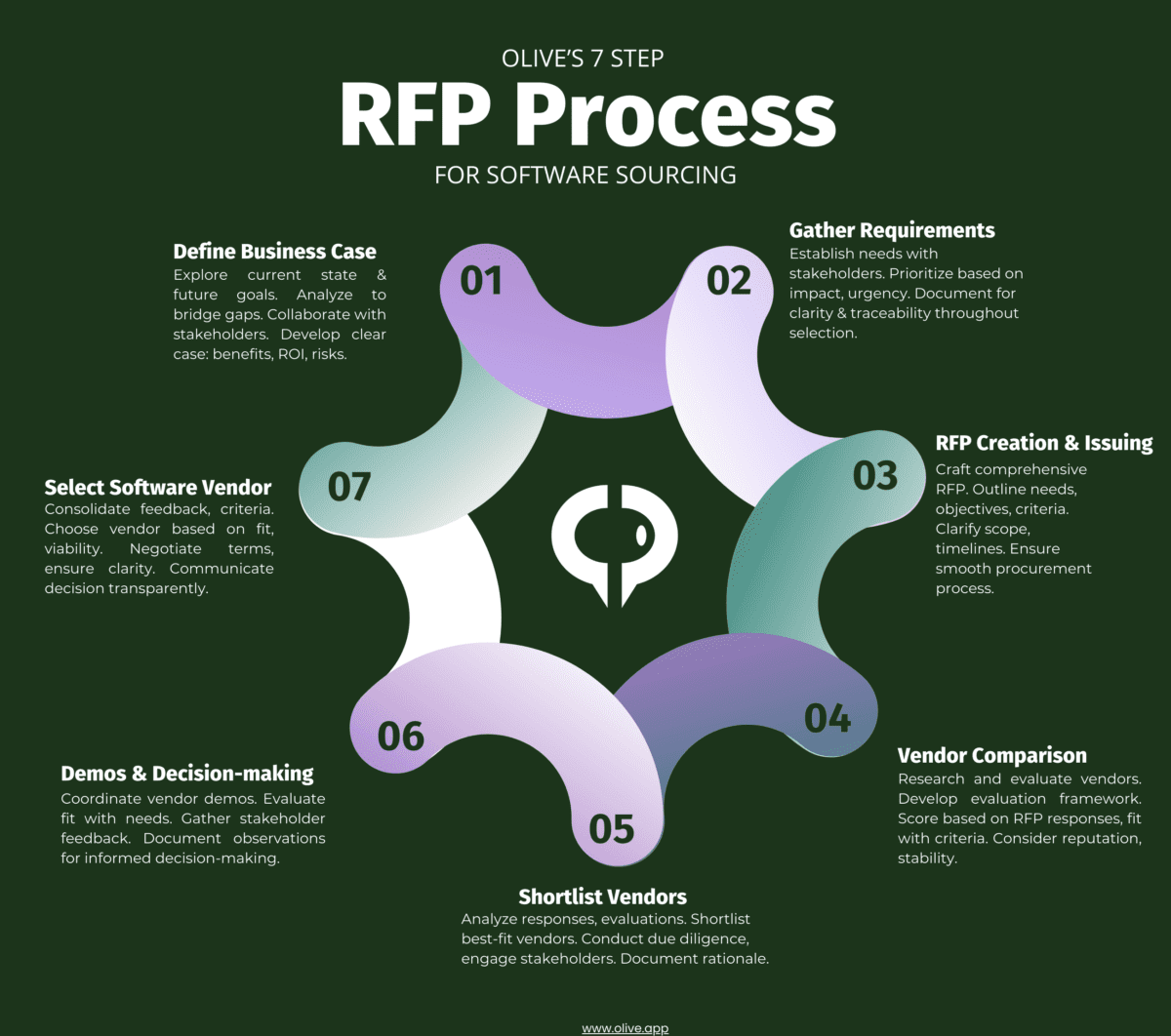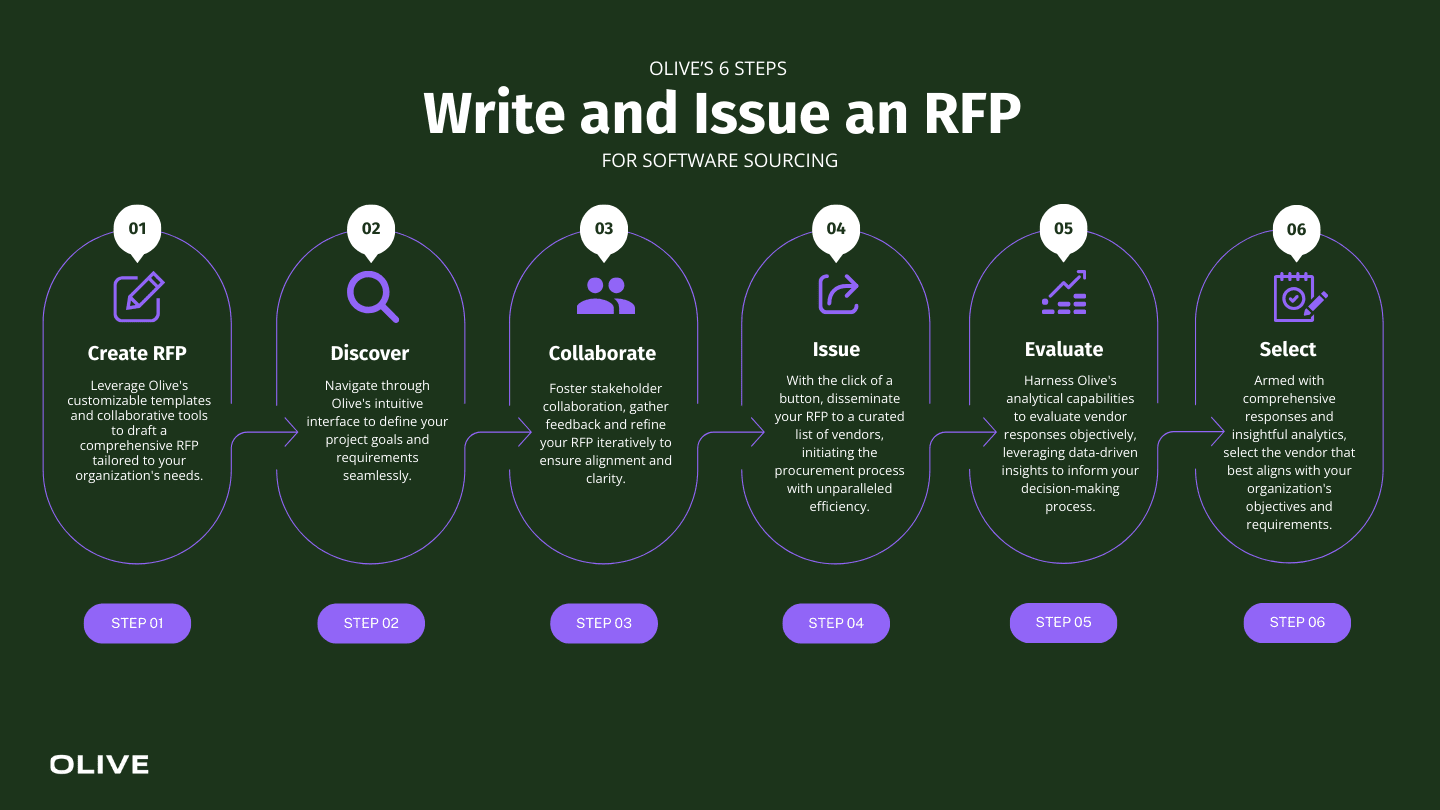Improve and Optimize Enterprise Technology and Software Purchasing: Say Goodbye to the Traditional RFP Process
When it comes to software sourcing and procurement, the request for proposal, or RFP, is a decades-old tool used every day worldwide. Indeed, thousands of businesses and organizations of all sizes go through the RFP process to collect and organize enterprise data, make strategic IT purchasing decisions, and find the best vendor.
Despite its pervasiveness, the RFP process continues to be frustrating for many departments due to its complexity and lengthiness. Not to mention the pressure and fiscal responsibility of selecting the best vendor for a mission-critical, high-value project on which your organization depends.
Fortunately, with preparation and direction, you’ll be able to navigate the process while adhering to best practices, securing competitive prices, and mitigating risk. There’s a lot to cover, from asking the right questions to scoring RFP responses to looking at how agile RFP technology tools can help you navigate the complexity of RFPs.
Stop guessing. See what a “Perfect RFP” looks like.
Side Note: If you don’t want to just read about the process—but actually experience best practices within an RFP solution, follow along with a free account.
You can create a free Olive account in less than a minute to access best-practice templates and streamline your evaluation today.
Rethinking the Traditional RFP Process
What is an RFP?
An RFP is a formal, questionnaire-style document issued to prospective vendors by an organization that intends to purchase a product or service. The RFP collects vendor data in a standardized and organized format. Although the RFP process intends to enable faster and easier vendor comparisons, it only sometimes delivers on this promise. With so many software solution vendors on the market (over 300 in some cases), manually looking at how all vendors meet your needs is overwhelming.
The process is designed to be an objective and systematic approach to sourcing and purchasing. But because of the lengthy nature of the RFP process, it can be convoluted and riddled with bias. The traditional enterprise software selection process can range between 6 and 18 months and span multiple IT project phases.


RFP Process Best Practice: 3 Phases
The RFP process comprises three fundamental phases: creating the RFP, administering it, and evaluating the responses.
1. Creation
The first phase in the process is to create and write an RFP. Planning, stakeholder interviews, research, gathering and ranking rfp requirements are all part of the process.
2. Issue the RFP
The second step of the RFP process includes selecting vendors, issuing your RFP, inviting vendors to respond, answering questions, iterating requirements waiting for proposals and following up as the deadline approaches.
3. Evaluation
The last phase of the RFP process is to review and compare the vendor proposals to select a winner. It’s crucial to engage stakeholders in this process to provide their perspectives and expertise.
Traditional RFPs can have endless requirements, but they use a manual process to consolidate this information into the purchase decision. RFPs that use Word or PDF documents lack the ability to consolidate the information. Although spreadsheets are more efficient than documents, they are also more limited and manual. While spreadsheet RFPs can use macros to aggregate product response scores, this requires coding expertise. Spreadsheets are useful for evaluating a small number of requirements, but they do not scale to enterprise software selection projects.
There is no easy way to compare multiple vendors in documents or spreadsheets. Information gathered from various RFPs must be manually consolidated, which is time-consuming and error-prone work. Furthermore, the people responsible for making a decision have biases that can influence the selection decision. The hope is that individual biases cancel each other out; but as we know, hope is not a rational approach to selecting software.
Who is involved in the RFP Process Software Sourcing?
RFPs are frequently initiated by an individual, department, or team requesting a solution. Often, input from relevant stakeholders directs the project. Having engaged stakeholders improves project outcomes. Often these business stakeholders contribute to the RFP.
IT
Teams sourcing enterprise technology heavily involve the IT department in the RFP (Request for Proposal) process. The IT department closely collaborates with teams to identify needs and requirements, research potential solutions, develop the RFP, evaluate vendor proposals, manage implementation, and provide ongoing support. The IT department plays a critical role in ensuring that the technology sourced meets the teams’ needs and requirements, and successfully implements and supports the selected solution.
Procurement Team
Procurement teams are critical to success because they are the architects and managers of the RFP process. They then make it easier to create, distribute, and evaluate RFPs. They collaborate with vendors throughout the process to track progress, answer questions, and provide feedback. Procurement managers and strategic sourcing managers often make up the procurement team.
Consultants
A procurement consultant may be hired by an organization that lacks the expertise or bandwidth to navigate the RFP process. Before making a recommendation, they interview the organization to understand its needs and then use their expertise to select qualified vendors, manage communication, and assess results.
Executives
An executive, chief procurement officer, or chief financial officer is usually tasked with providing final approval for a high-cost, strategic procurement project. They will consider the cost, the expected return on investment, and the alignment with organizational goals.
Finance, CFO
CFOs, and finance teams support the company’s strategy development by helping key business leaders quantitatively analyze financial implications. As such, the CFO and finance team act as stewards of future value in the RFP strategy process by critically examining the risks to, and expected returns on, different vendor alternatives.
Department Heads
RFPs should not be siloed to procurement teams, they need a more holistic approach. Various department heads should also make up the overall involvement process. Some companies have executives who manage RFPs by working with department heads. Many times, department managers issue RFPs related to projects in their departments. Some companies appoint committees made up of members of the finance, sales, legal, product and marketing teams to handle RFP-related tasks.
Vendors
Organizations invite vendors to respond to an RFPs. Traditionally, Vendors create a proposal that addresses the RFP questions, emphasizes their differentiators, and, ideally, persuades the buyer that they are the best fit for the project.
Why Must Organizations Issue RFPs?
Simply put, organizations issue RFPs to select the right vendor to meet their specific criteria. This includes factors such as:
- Accounting for complex considerations: When an organization needs to make a high-value purchase, they must take multiple considerations into account, such as a vendor’s experience, technical knowledge, security practices, and product quality. The RFP intends to synthesize this information from multiple vendors in one document. However, it often falls short, resulting in information overload that can be difficult to navigate.
- Competitive pricing: RFP purchases are frequently hefty investments. As a result, it’s critical to work with the right company while keeping costs as low as possible. RFPs are competitive by definition, which encourages each potential vendor to present their best offer. However, please remember that a vendor’s best offer may not be the best for your specific criteria. This is where streamlining your RFP with the right digital tools will come in handy. (more on that later)
- A fair and unbiased selection process to find best-fit solutions: RFP advocates claim that data collected in the RFP process ensures objectivity. Although it does allow you to gather consistent data from prospective suppliers, the process does not come without its fair share of favoritism, bias, and unfair comparisons. For example, many organizations will look for top-rated vendors on G2 or Gartner, and automatically assume that the highest rank vendors are the right ones for their organization. However, just because vendors have received five star ratings, doesn’t mean that they’re the right fit for your organization.
When To Issue an RFP
RFPs aren’t appropriate for every IT purchase because of the time it takes to create and manage them. Remember, the purpose of the RFP is to save money and protect your company. So, if you are making a small, one-time purchase, the risk is likely to be low, and the time investment in preparing an RFP may outweigh the potential benefit.
Organizations commonly include a cost threshold in their procurement policy to help provide guidance. An RFP must be issued if the project budget meets or exceeds the specified amount. The threshold varies depending on the size of the organization, but it is typically between $5,000 and $250,000. Traditionally Enterprises wouldn’t bother with RFPs for smaller purchases, due to the time and effort investment, however, with recent understanding of Shadow IT threats, it’s wise to consider a solution to maintain effective RFP processes internally.
Issue RFPs like a Pro: Source the Right RFP Software for Your Enterprise
What are the 7 Steps in the RFP Process?
1. Discovery: Defining the Business Case
Before diving into the software selection process, it’s essential to embark on a thorough exploration of the organization’s current state and future objectives. This entails conducting a comprehensive analysis to identify areas where a new software solution could potentially bridge gaps or capitalize on opportunities. Collaboration with key stakeholders from various departments is paramount to ensure alignment with overarching business goals. Through this process, a clear business case is developed, outlining the anticipated benefits, projected return on investment (ROI), and potential risks associated with implementing a new software solution.
2. Requirements Gathering: Understanding Business Needs
With the business case established, the next step involves delving into the intricacies of identifying and documenting business requirements. This phase requires close collaboration with stakeholders across departments, leveraging techniques such as workshops, interviews, and surveys to gain insights into their needs and preferences. Requirements are prioritized based on their impact on business objectives, urgency, and feasibility of implementation. Documenting these requirements in a structured format ensures clarity and traceability throughout the selection process.
3. Create and Issue RFP
Crafting a comprehensive Request for Proposal (RFP) marks the initiation of the formal procurement process. The RFP document serves as a roadmap for potential vendors, outlining the organization’s needs, objectives, and evaluation criteria. It provides a clear understanding of the project scope, including functional and technical requirements, integration needs, and any specific contractual or compliance requirements. Setting clear timelines and expectations for vendor responses is essential to ensure a smooth and efficient procurement process.
4. Vendor Comparison
Researching and evaluating potential vendors is a meticulous process that involves gathering information from various sources, including industry reports, peer recommendations, and online reviews. A structured evaluation framework is developed to assess vendors based on criteria such as functionality, scalability, reliability, support, and total cost of ownership. Vendors are objectively scored and ranked based on their responses to the RFP and their fit with the organization’s requirements. Factors such as vendor reputation, track record, financial stability, and cultural fit are also considered during the evaluation process.


5. Shortlisting Best-fit Solution Vendors
Analyzing RFP responses and vendor evaluations helps identify a shortlist of vendors that best meet the organization’s needs. Additional due diligence, such as reference checks, product demonstrations, and site visits, is conducted to validate vendor capabilities and suitability. Key stakeholders are engaged in the shortlisting process to ensure buy-in and alignment with organizational goals. The rationale for shortlisting each vendor is documented, highlighting their strengths and areas of alignment with the organization’s requirements.
6. Demos and Decision-making
Coordinating product demonstrations with shortlisted vendors allows stakeholders to assess their solutions in action and evaluate their fit with the organization’s needs. Use cases and scenarios are developed to guide the demonstrations and ensure coverage of key functionalities and workflows. Stakeholder feedback is solicited during the evaluation process, and observations, feedback, and concerns raised during the demonstrations are documented to support informed decision-making.
7. Selecting the Right Software Vendor
Consolidating feedback from stakeholders and evaluation criteria enables an objective decision about the preferred vendor. Factors such as vendor responsiveness, flexibility, willingness to collaborate, and long-term viability are considered during the final decision-making process. Contract terms and pricing are negotiated with the selected vendor, ensuring clarity and alignment on key terms and conditions. Transparent communication about the decision is provided to all stakeholders, along with next steps for implementation.


How to Improve and Optimize the RFP Process with Olive
Innovation exists for a reason. Using new technology to add value to an existing idea or product and push boundaries further. The RFP process in particular, is in desperate need of innovation.
Organizations can leverage Olive’s advanced capabilities to streamline the process of creating and issuing software RFPs, ensuring comprehensive coverage of requirements, and collaboration among stakeholders. Olive significantly enhances the efficiency and effectiveness of the RFP process, making it the ideal choice for organizations seeking to initiate and manage software RFPs seamlessly.

We’ve helped countless organizations go from wasting months on the evaluation process to getting quick, streamlined results with Olive. For example, Chris Abram, Director of Innovation at Dewey’s Pizza, shared how Olive helped the company transition from multiple spreadsheets and documents into one centralized platform.
Instead of wasting time and money with outdated RFP Creation platforms – choose Olive and experience the benefits of modern, efficient online RFP software.





